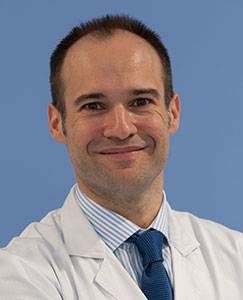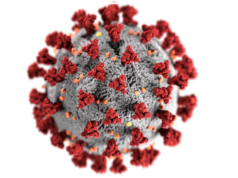
Determining the potential role of interventional radiologists in obesity treatment is increasingly important, as the global number of obese patients has long since swollen to pandemic proportions. In this commentary, Alberto Alonso discusses the importance of having a multifactorial approach to obesity treatment, focusing on the unique needs of specific patients. Left gastric artery embolization has been proposed as a promising strategy to treat obesity due to the procedure’s ability to suppress the production of “the hungry hormone” ghrelin, but Alonso argues that the procedure alone is not enough to act as the curative treatment some have hailed it as.
Obesity is defined as a state of increased adipose tissue of enough magnitude to produce adverse health consequences, and is associated with increased morbidity and mortality. Obesity is a pandemic health problem involving genetics, the environment, other diseases, drugs and psychological factors. Treatment for obesity should never be considered “unilateral”—not even a surgical approach should be seen as a standalone option. Obesity always requires a multidisciplinary and tailored approach, focusing on caloric reduction and increased physical activity. Considering a single intervention as an adequate “curative treatment” for obesity is arrogant and most likely will not work.
Lifestyle and dietary changes are probably the best focus for obesity treatment. However, these have proven ineffective in the long-term for the most obese patients. Anti-obesity medications are not without significant side effects, and they are expensive. Gastric volume reduction remains the most effective mechanism currently available to control obesity.
The mechanisms dictating food intake and appetite are complex and, mainly, not well known. Many hormones (such as ghrelin, leptin, obestatin, and insulin) are involved through neural pathways in the “simple” act of eating. Ghrelin, the “hunger hormone” is a peptide hormone produced by ghrelinergic cells in the gastrointestinal tract that functions as a neuropeptide in the central nervous system by regulating appetite, but also plays an important role in regulating the distribution and rate of energy usage. It acts on hypothalamic brain cells to increase hunger: ghrelin is secreted when the stomach is empty, and secretion stops when the stomach is full.
Left gastric artery embolization
Left gastric artery embolization (LGAE) has been proposed as an alternative to bariatric surgery for weight loss due to its effects on the ghrelin hormone. In theory, by reducing the blood supply to the fundus of the stomach via LGAE, the release of ghrelin should decrease and relieve the feeling of hunger, ultimately resulting in the patient eating less. Theoretically.
However, ghrelin also plays an important role in regulating reward perception via dopamine levels in central nervous system neurons, also linked to processing sexual desire, reward, and reinforcement, as well as in developing addictions. Paradoxically, ghrelin plasma levels in obese individuals are lower than those in leaner individuals, suggesting that ghrelin does not contribute to obesity (except in the cases of Prader-Willi syndrome-induced obesity). However, it has also been reported that consumption of “food for pleasure” increases peripheral levels of both ghrelin and the endocannabinoid 2-arachidonoyl-glycerol in healthy humans. This should then also be considered as an underlining psychological factor in any patient with severe obesity, where anxiety and depression are concomitant entities in many cases. Reducing obesity only to “over-eating” and this to a “ghreling secretion” is probably an extremely simplified, and incorrect, point of view.
After LGAE, ghrelin levels initially decrease, then increase at three and six-months’ follow-up to a wide range of values; the same variation is seen in weight loss following LGAE. This may be due to revascularisation of the gastric fundus but also, more interestingly, to the return of appetite after gastric recovery from ischaemic injury, where ischaemic ulcers are widely observed after LGAE.
Evidence of long term reduction in levels of the ghrelin hormone after LGAE has not been confirmed due to limited experience; data regarding the potential role of LGAE for weight loss is scarce. In fact, no clinical trial with long-term follow-up and a relatively large sample size has been reported. Even if it is mainly produced by stomach fundus cells, there are also ghrelin-secreting cells in the proximal intestine, pancreas, pituitary gland, and colon. Those should increase ghrelin secretion after LGAE.
LGAE is effective on its own—probably more due to ischaemic gastric ulcers than to ghrelin secretion—but its efficacy may be enhanced if performed in combination with other therapies, lifestyle modifications, and/or pharmacotherapy. This focus has not been described.
Almost any intervention that leads to a caloric deficit in a severely obese patient will be followed by an initial benefit. In fact, the literature reports that for patients treated with LGAE, glycated haemoglobin (HbA1c) levels were under control following the procedure, and a 10% weight loss had been observed. As in any dietic intervention, the crucial question is: for how long do these benefits last?
The ideal candidate
Identifying the best candidates for the procedure is still a work in progress, as is discerning the long-term outcome. Defining obesity as having a body mass index (BMI) greater than 30kg/m2 is common in published work. BMI is the most frequently used measurement for diagnosing obesity, because of its simplicity and reliability. Excess adiposity but not excess body weight is the real culprit of obesity-associated complications. However, in comparison with techniques involving the direct measurement of adipose, BMI underestimates the prevalence of obesity by 50%; its relationship with adiposity is influenced by age, sex and race. Lean body mass (LBM) is a component of body composition, calculated by subtracting body fat weight from total body weight. LBM has been described as a superior index to total body weight for prescribing proper levels for assessing metabolic disorders. When papers only attend to BMI and absolute weight loss, how can we determine how LGAE affects LBM? Has it been improved or worsed by LGAE? This point should be clarified before considering LGAE as standard treatment.
The ideal embolic agent for LGAE is still uncertain, where agent penetration, devascularisation and revascularisation are the key features. Is a temporary occlusion desired or better than a definitive embolization? Several different types and sizes of embolic agents and spherical particles have been used. The ideal endpoint for embolization also needs to be clarified.
Finally, LGAE reduces future options for an established surgical bariatric procedure. The idea of a gastric volume reduction with a previous devascularised area could be considered as a contraindication for surgery in many of the working groups. Adjustable gastric banding may then be the only option, even when this cannot be considered an adequate second bariatric option.
So, when should LGAE be used? Not as an alternative to surgery, and neither as a bridge to surgery—and definetively not as a solo treatment for obesity. LGAE should be restricted to those patients with a concious and complete refusal of surgery and as an initial starting point for weight loss. But we should always bear in mind that LGAE is only capable of causing a temporary effect.
Alberto Alonso is an interventional radiologist at the Clínica Universidad de Navarra in Madrid, Spain.
References:
1. Zhong BY, Abiola G, Weiss CR. Bariatric Arterial Embolization for Obesity: A Review of Early Clinical Evidence. Cardiovasc Intervent Radiol (2018) 41: 1639.
2. Shoar S, Saber AA, Aladdin M, et al. Bariatric manipulation of gastric arteries: a systematic review on the potential concept for treatment of obesity. Int Jo Surg. 2016;36:177–82.
3. Angrisani L, Santonicola A, Vitiello A, Ferraro L, Iovino P. Reply to Letter to the Editor “Left Gastric Artery Embolization for Weight Loss-a Dead-End Procedure”. Obes Surg. 2018;28(11):3627-28.
4. Fink JM, Martini V, Seifert G et al, Marjanovic G. Left Gastric Artery Embolization for Weight Loss-a Dead-End Procedure. Obes Surg. 2018;28(11):3623-24.
5. Saeed Shoar, Alan A. Saber, Mohammaed Aladdin et al. Bariatric manipulation of gastric arteries: A systematic review on the potential concept for treatment of obesity, International Journal of Surgery. 2016; 36, 177-182.
6. Weiss CR, Akinwande O, Paudel K et al. Clinical Safety of Bariatric Arterial Embolization: Preliminary Results of the BEAT Obesity Trial. Radiology. 2017;283:598-608.
7. Syed MI, Morar K, Shaikh A, Craig P, Khan O, Patel S, Khabiri H. Gastric Artery Embolization Trial for the Lessening of Appetite Nonsurgically (GET LEAN): Six-Month Preliminary Data. J Vasc Interv Radiol. 2016;27(10):1502-8













